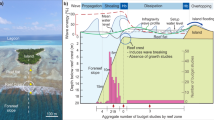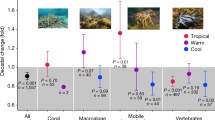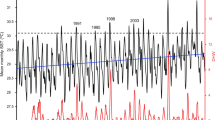Abstract
In the high-salinity seaward portions of estuaries, oysters seek refuge from predation, competition and disease in intertidal areas1,2, but this sanctuary will be lost if vertical reef accretion cannot keep pace with sea-level rise (SLR). Oyster-reef abundance has already declined ∼85% globally over the past 100 years, mainly from over harvesting3,4, making any additional losses due to SLR cause for concern. Before any assessment of reef response to accelerated SLR can be made, direct measures of reef growth are necessary. Here, we present direct measurements of intertidal oyster-reef growth from cores and terrestrial lidar-derived digital elevation models. On the basis of our measurements collected within a mid-Atlantic estuary over a 15-year period, we developed a globally testable empirical model of intertidal oyster-reef accretion. We show that previous estimates of vertical reef growth, based on radiocarbon dates and bathymetric maps5,6, may be greater than one order of magnitude too slow. The intertidal reefs we studied should be able to keep up with any future accelerated rate of SLR (ref. 7) and may even benefit from the additional subaqueous space allowing extended vertical accretion.
This is a preview of subscription content, access via your institution
Access options
Subscribe to this journal
Receive 12 print issues and online access
$209.00 per year
only $17.42 per issue
Buy this article
- Purchase on Springer Link
- Instant access to full article PDF
Prices may be subject to local taxes which are calculated during checkout



Similar content being viewed by others
References
White, M. E. & Wilson, E. A. in The Eastern Oyster: Crassostrea virginica (eds Kennedy, V. S., Newell, R. I. E. & Eble, A. F.) Ch. 16, 559–579 (Maryland Sea Grant, 1996).
Bahr, L. M. & Lanier, W. P. The ecology of intertidal oyster reefs in the South Atlantic: A community profile. 105 (US Fish and Wildlife Service, Office of Biological Services 1981).
Kirby, M. X. Fishing down the coast: Historical expansion and collapse of oyster fisheries along continental margins. Proc. Natl Acad. Sci. USA 101, 13096–13099 (2004).
Beck, M. W. et al. Oyster reefs at risk and recommendations for conservation, restoration, and management. Bioscience 61, 107–116 (2011).
DeAlteris, J. T. The geomorphic development of wreck shoal, a subtidal oyster reef of the James River, Virginia. Estuaries 11, 240–249 (1988).
Wang, H. & Van Strydonck, M. Chronology of Holocene cheniers and oyster reefs on the coast of Bohai Bay, China. Quat. Res. 47, 192–205 (1997).
Rahmstorf, S. A new view on sea level rise. Nature Rep. Clim. Change 44–45 (2010).
Dame, R. F., Spurrier, J. D. & Wolaver, T. G. Carbon, Nitrogen and Phosphorus processing by an oyster reef. Mar. Ecol. Prog. Ser. 54, 249–256 (1989).
Grabowski, J. H. & Peterson, C. H. in Ecosystem Engineers: Concepts, Theory and Applications (eds Cuddington, K., Beyers, J. E., Wilson, W. G. & Hastings, A.) 281–298 (Elsevier-Academic, 2007).
Tolley, S. G. & Volety, A. K. The role of oysters in habitat use of oyster reefs by resident fishes and decapod crustaceans. J. Shellfish Res. 24, 1007–1012 (2005).
Meyer, D. L., Townsend, E. C. & Thayer, G. W. Stabilization and erosion control value of oyster cultch for intertidal marsh. Restor. Ecol. 5, 93–99 (1997).
Piazza, B. P., Banks, P. D. & La Peyre, M. K. The potential for created oyster shell reefs as a sustainable shoreline protection strategy in Louisiana. Restorat. Ecol. 13, 499–506 (2005).
Waldbusser, G. G. & Salisbury, J. E. Ocean acidification in the coastal zone from an organism’s perspective: multiple system parameters, frequency domains, and habitats. Ann. Rev. Mar. Sci. 6, 221–247 (2014).
Bishop, M. & Peterson, C. Direct effects of physical stress can be counteracted by indirect benefits: Oyster growth on a tidal elevation gradient. Oecologia 147, 426–433 (2006).
Powers, S. P., Peterson, C. H., Grabowski, J. H. & Lenihan, H. S. Success of constructed oyster reefs in no-harvest sanctuaries: Implications for restoration. Mar. Ecol. Prog. Ser. 389, 159–170 (2009).
Mann, R., Harding, J. M. & Southworth, M. J. Reconstructing pre-colonial oyster demographics in the Chesapeake Bay, USA. Estuar. Coast. Shelf Sci. 85, 217–222 (2009).
Powell, E. N., Klinck, J. M., Ashton-Alcox, K., Hofmann, E. E. & Morson, J. The rise and fall of Crassostrea virginica oyster reefs: The role of disease and fishing in their demise and a vignette on their management. J. Mar. Res. 70, 505–558 (2012).
Grabowski, J. H., Hughes, A. R., Kimbro, D. L. & Dolan, M. A. How habitat setting influences restored oyster reef communities. Ecology 86, 1926–1935 (2005).
Hargis, W. J. & Haven, D. S. in Chesapeake Oyster Reefs, their Importance, Destruction and Guidelines for Restoring them (eds Luckenback, M. W., Mann, R. & Wesson, J. A.) 329–358 (Virginia Institute of Marine Sciences Press, 1999).
Ortega, S. & Sutherland, J. P. Recruitment and growth of the Eastern Oyster, Crassostrea virginica, in North Carolina. Estuaries 15, 158–170 (1992).
Thomsen, M. S. & McGlathery, K. Effects of accumulations of sediments and drift algae on recruitment of sessile organisms associated with oyster reefs. J. Exp. Mar. Biol. Ecol. 328, 22–34 (2006).
Davies, D. J., Powell, E. N. & Stanton, R. J. Relative rates of shell dissolution and net sediment accumulation–a commentary: Can shell beds form by the gradual accumulation of biogenic debris on the sea floor? Lethaia 22, 207–212 (1989).
Hess, K. W., Spargo, E. A., Wong, A., White, S. A. & Gill, S. VDATUM for Central Coastal North Carolina: Tidal Datums, Marine Grids, and Sea Surface Topography 46 (NOAA, Silver Spring, 2005).
Delaune, R. D., Patrick Jr, W. H. & Buresh, R. J. Sedimentation rates determined by 137Cs dating in a rapidly accreting salt marsh. Nature 275, 532–533 (1978).
Gunnell, J. R., Rodriguez, A. B. & McKee, B. A. How a marsh is built from the bottom up. Geology 41, 859–862 (2013).
Bos, A. R., Bouma, T. J., de Kort, G. L. J. & van Katwijk, M. M. Ecosystem engineering by annual intertidal seagrass beds: Sediment accretion and modification. Estuar. Coast. Shelf Sci. 74, 344–348 (2007).
Palinkas, C. & Koch, E. Sediment accumulation rates and submersed aquatic vegetation (SAV) distributions in the Mesohaline Chesapeake Bay, USA. Estuar. Coasts. 35, 1416–1431 (2012).
Breithaupt, J. L., Smoak, J. M., Smith, T. J., Sanders, C. J. & Hoare, A. Organic carbon burial rates in mangrove sediments: Strengthening the global budget. Glob. Biogeochem. Cycles 26, GB3011 (2012).
Vermeer, M. & Rahmstorf, S. Global sea level linked to global temperature. Proc. Natl Acad. Sci. USA 106, 21527–21532 (2009).
Grabowski, J. H. et al. Economic valuation of ecosystem services provided by oyster reefs. Bioscience 62, 900–909 (2012).
Acknowledgements
We thank A. Poray, A. Tyler, N. Anderson, E. Voigt, C. Baillie, G. Safrit, J. Hancock, S. Fuller and the NC Division of Marine Fisheries (C. Hardy, M. Jordan and G. Hardin) for assistance in constructing experimental reefs and P. Rodriguez for processing cores. This research was supported by funding from the Albemarle-Pamlico National Estuary Program to N.L.L., F.J.F. and A.B.R., North Carolina Sea Grant to A.B.R. and F.J.F., North Carolina Marine Resources Fund (CRFL) to A.B.R., NOAA-NERRS Graduate Research Fellowship Program (NOAA award Number 97-040-NOC) to J.H.G., the North Carolina Fishery Resource Grant Program (FRG Project Number 97-EP-06 and 98-EP-16) to J.H.G., and the National Science Foundation (OCE-1155628) to F.J.F. and (OCE-1203859) to J.H.G.
Author information
Authors and Affiliations
Contributions
A.B.R., F.J.F., J.H.G. and N.L.L. conceived of the project. A.B.R., F.J.F., J.T.R., E.J.T. and S.E.C. collected field data. A.B.R., J.T.R. and S.E.C. processed data. A.B.R. wrote the article. All authors constructed experimental reefs, contributed to discussions and interpretations of the results, and edited the manuscript.
Corresponding author
Ethics declarations
Competing interests
The authors declare no competing financial interests.
Supplementary information
Rights and permissions
About this article
Cite this article
Rodriguez, A., Fodrie, F., Ridge, J. et al. Oyster reefs can outpace sea-level rise. Nature Clim Change 4, 493–497 (2014). https://doi.org/10.1038/nclimate2216
Received:
Accepted:
Published:
Issue Date:
DOI: https://doi.org/10.1038/nclimate2216
This article is cited by
-
Oyster reef restoration facilitates the recovery of macroinvertebrate abundance, diversity, and composition in estuarine communities
Scientific Reports (2022)
-
High carbon accumulation rates in sediment adjacent to constructed oyster reefs, Northeast Florida, USA
Journal of Coastal Conservation (2021)
-
Natural Intertidal Oyster Reef Growth Across Two Landscape Settings and Tidal Ranges
Estuaries and Coasts (2021)
-
Coping with climate variability and non-climate stressors in the West African Oyster (Crassostrea tulipa) fishery in coastal Ghana
Maritime Studies (2020)
-
Oyster breakwater reefs promote adjacent mudflat stability and salt marsh growth in a monsoon dominated subtropical coast
Scientific Reports (2019)



